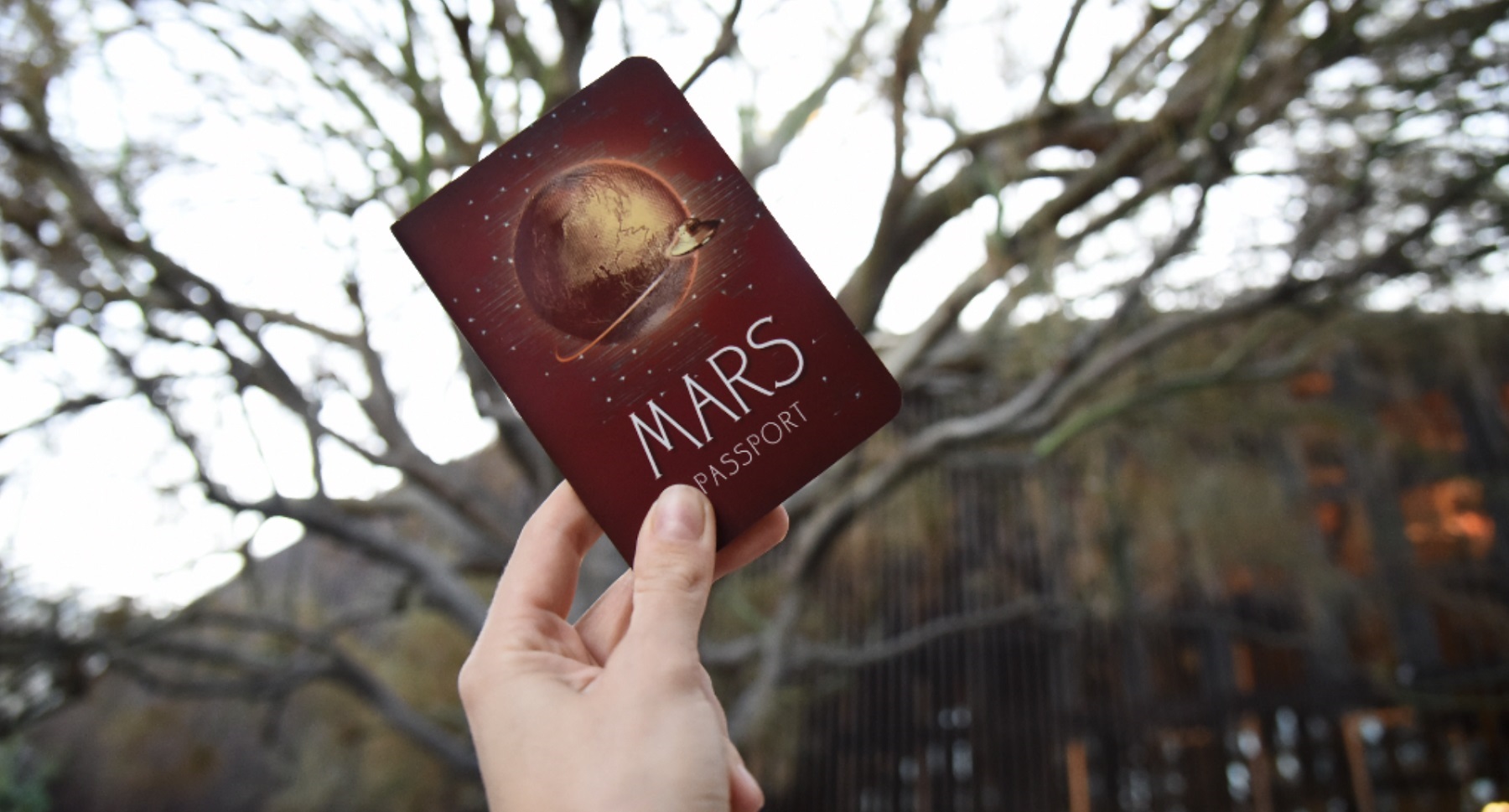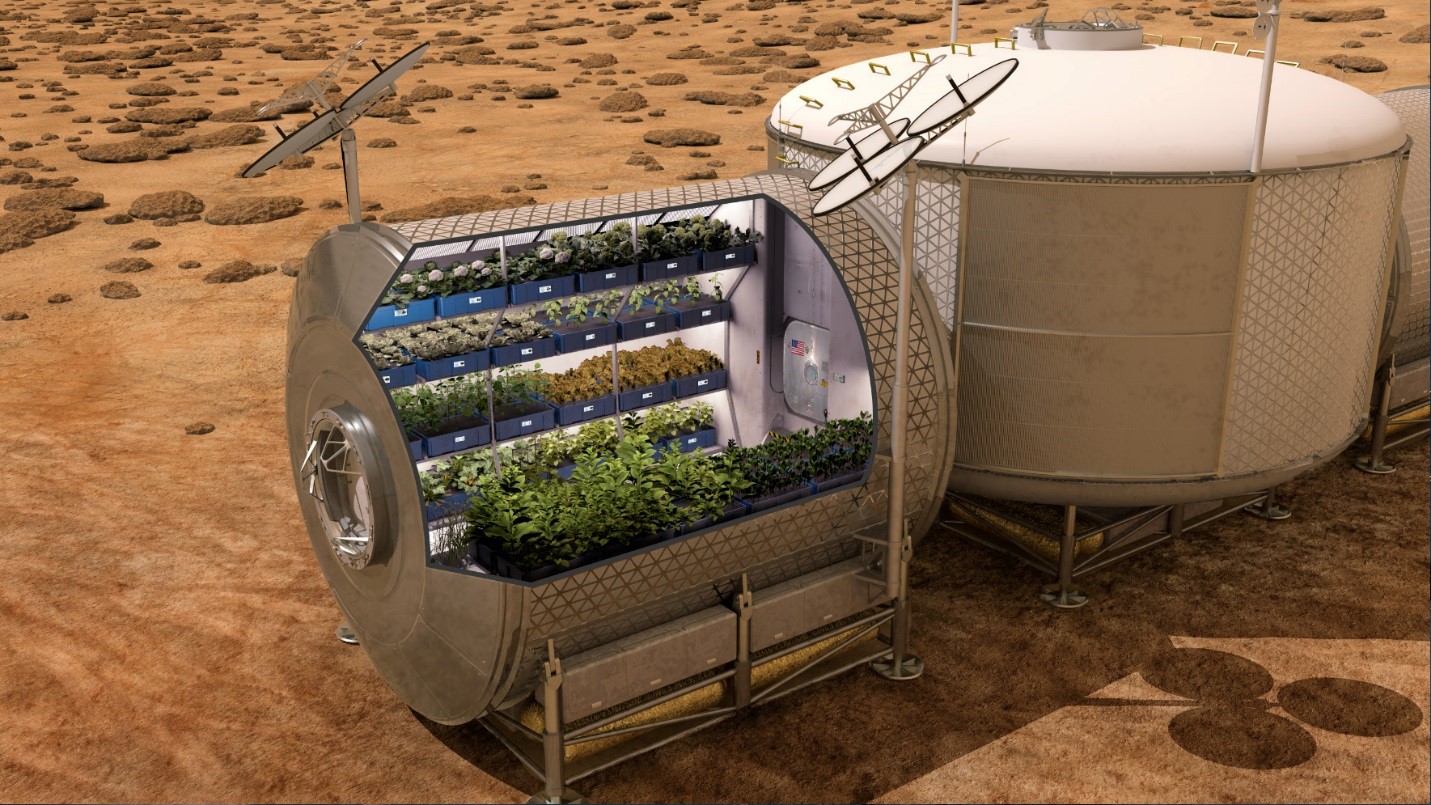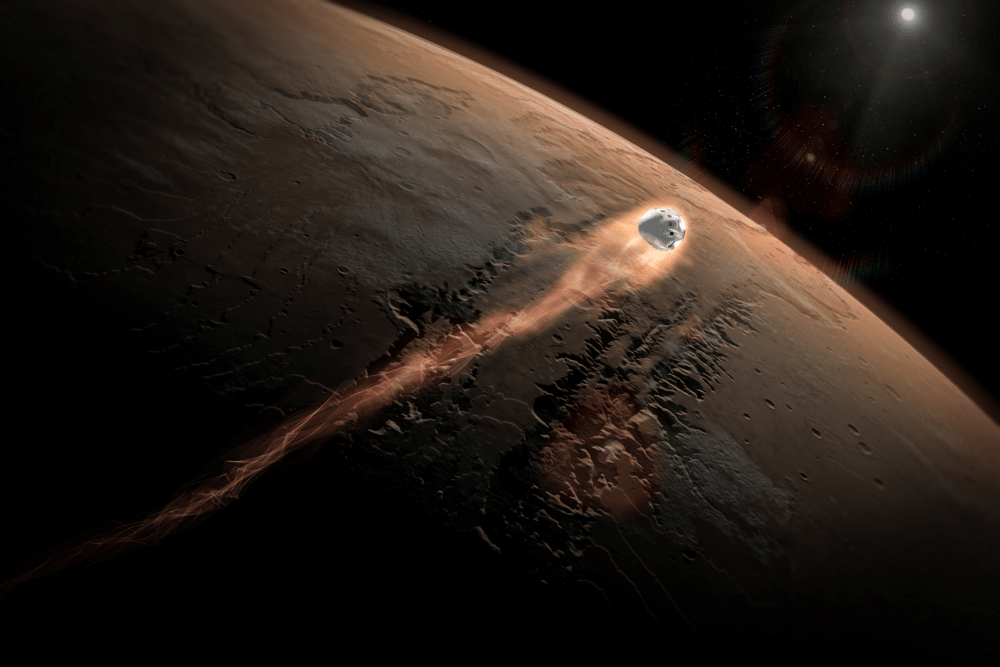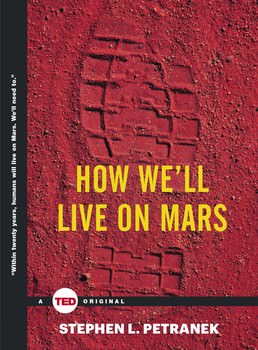What would the economy of a future Mars society look like, and how could it be self-sustaining while being completely sovereign from Earth and its own economy? This is what a recent study submitted to Space Policy hopes to address as a sole researcher discusses a model that could be used for establishing economic freedom on Mars, enabling both monetary and political stability across all Red Planets settlements. This study holds the potential to help scientists, economists, and world leaders better understand plausible governmental systems used by human settlers on other worlds while maintaining sovereignty from Earth and its own governmental law and order.
Continue reading “What could a future sovereign Mars economy look like?”Fish Could Turn Regolith into Fertile Soil on Mars
What a wonderful arguably simple solution. Here’s the problem, we travel to Mars but how do we feed ourselves? Sure we can take a load of food with us but for the return trip that’s a lot. If we plan to colonise the red planet we need even more. We have to grow or somehow create food while we are there. The solution is an already wonderfully simple ‘biosphere’ style system; a fish tank! New research suggests fish could be raised in an aquatic system and nutrient rich water can fertilise and grow plants in the regolith! A recent simulation showed vegetables could be grown in regolith fertilised by the fish tank water!
Continue reading “Fish Could Turn Regolith into Fertile Soil on Mars”What’s the Bare Minimum Number of People for a Mars Habitat?
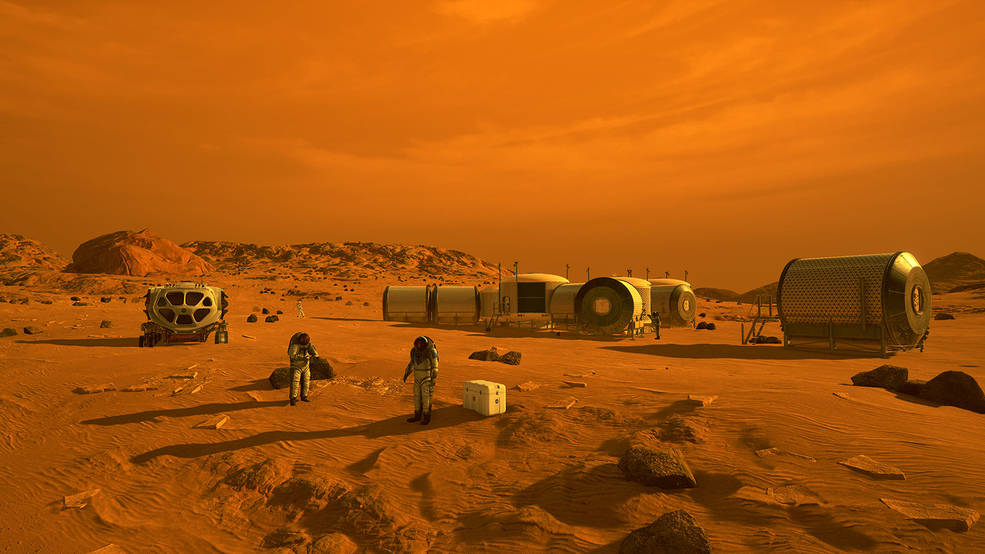
A recent preprint paper examines the minimum number of people required to maintain a feasible settlement on Mars while accounting for psychological and behavioral factors, specifically in emergency situations. This study was conducted by a team of data scientists from George Mason University and holds the potential to help researchers better understand the appropriate conditions for a successful long-term Mars settlement, specifically pertaining to how those settlers will get along during all situations. But why is it important to better understand the psychological factors pertaining for a potential future Mars colony?
Continue reading “What’s the Bare Minimum Number of People for a Mars Habitat?”This is why Martian Colonists are Going to Wish They had an Atmosphere Above Them

There will be all sorts of risks for any future colonists on Mars, such as extreme weather and temperatures, radiation, and the human physiological problems associated with living in with decreased gravity. But another issue means colonists on Mars will have to be on a constant lookout above their heads.
Continue reading “This is why Martian Colonists are Going to Wish They had an Atmosphere Above Them”Behold! The Martian Menu, Courtesy of Mars City Design!
Today, there is no shortage of people who want to see humans go to Mars in their lifetime. Moreover, many want to go there themselves, and some even want to stay! It goes without saying that this proposed endeavor presents all kinds of challenges (the word Herculean comes to mind!) This is especially true when it comes to feeding future missions to Mars, not to mention permanent residents.
Regular resupply missions to Mars are simply not feasible, which means astronauts and settlers will have to grow their own food. To inspire ideas for how this could be done, and what the resulting meals would be like, Vera Mulyani and the organization she founded (Mars City Design) created the Martian Feast Gala. This annual event showcases what a Martian Menu could consist of and illustrates how every challenge is an opportunity to get creative!
Continue reading “Behold! The Martian Menu, Courtesy of Mars City Design!”What Will It Take To Feed A Million People On Mars?
In 2017, Elon Musk laid out his grand sweeping plans for the future of SpaceX, the company that would take humanity to Mars. Over decades, tens of thousands of Starship flights would carry a million human beings to the surface of the Red Planet, the minimum Musk expects it’ll take to create a self-sustaining civilization.
Continue reading “What Will It Take To Feed A Million People On Mars?”SpaceX & NASA Studying 2020 Landing Sites For Dragon
As part of their effort to kick-start the eventual colonization of Mars, SpaceX is sending an unmanned Dragon spacecraft to Mars. Initially, that mission was set for 2018, but is now re-scheduled for 2020. Now, SpaceX says they’re working with NASA to select a suitable landing site for their first Dragon mission to Mars.
At a presentation in Texas on March 18th, Paul Wooster of SpaceX said that they have been working with scientists at NASA’s Jet Propulsion Laboratory (JPL) to identify candidate landing sites on the surface of Mars. In order to aid colonization, the sites need to be:
- near the equator, for solar power
- near large quantities of ice, for water
- at low elevation, for better thermal conditions
But finding a site that meets those conditions is difficult.
According to SpaceNews, the study done with NASA initially recognized 4 regions in Mars’ northern hemisphere, all within 40 degrees of the equator. They are Deuteronilus Mensae, Phlegra Montes, Utopia Planitia, and Arcadia Planitia.
Deuteronilus Mensae
Deuteronilus Mensae (DM) is located between older, cratered highlands and low plains. DM shows evidence of glacial activity in its surface features. In fact, there are still glaciers there, which makes it a desirable source of ice.

Phlegra Montes
Phlegra Montes (PM) is a system of mountains on the Martian surface, over 1300 km across. It’s a complex system of basins, hills, and ridges. They are likely tectonic in origin, rather than volcanic, and the region probably contains large quantities of water ice, perhaps 20 meters below the surface.

Utopia Planitia
Utopia Planitia (UP) is the region where the Viking 2 lander set down in 1976. At 3300 km in diameter, UP is the largest impact basin in the Solar System. In 2016, NASA found a huge deposit of underground ice there. The water is estimated to be the same volume as Lake Superior.

Arcadia Planitia
Arcadia Planitia (AP) is a smooth plain containing fresh lava flows. It also has a large region that was shaped by periglacial processes. This supports the idea that ice is present just beneath the surface, making it a candidate for colonization efforts.

The image below shows the Arcadia Planitia region in relation to some of its surroundings. Colonists at AP might have a great view of Olympus Mons, the largest volcano in the Solar System.
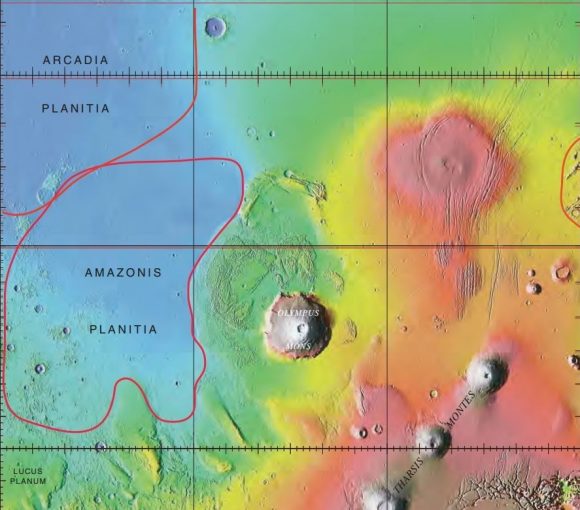
The four areas looked suitable in images from a medium resolution camera (CTX) on the Mars Reconnaissance Orbiter (MRO). But when the High Resolution Imaging Science Experiment (HiRISE) camera on the same orbiter was used to look more closely, the first three locations appeared to be much rockier. According to SpaceNews, Wooster said ““The team at JPL has been finding that, while the areas look very flat and smooth at CTX resolution, with HiRISE images, they’re quite rocky. That’s been unfortunate in terms of the opportunities for those sites.”
The fourth area, Arcadia Planitia, is a more promising site. HiRISE images showed that it is much less rocky and could be a suitable site for the first Dragon mission to Mars.
The Dragon mission to Mars is just the first step for SpaceX. They see themselves as an interplanetary transportation company eventually. SpaceX intends to send a craft to Mars every two years, when the launch window is optimal. SpaceX says they’ll have the ability to deliver one ton of payload to the Martian surface with each Dragon mission.
Their Interplanetary Transport System (ITS) might have the capability to make it to Mars in as little as 80 days, while carrying a payload of up to 450 tons. While still in the very initial stages of design, it may eventually revolutionize our ability to colonize Mars in any meaningful or enduring way. SpaceX envisions a fleet of craft in the ITS which will constantly make the return to trip to Mars.
If that ever happens, we may look at the first Dragon mission to Arcadia Planitia, or another eventual landing site, as the first step.
SpaceX Announces Plan to Launch Private Dragon Mission to Mars in 2018

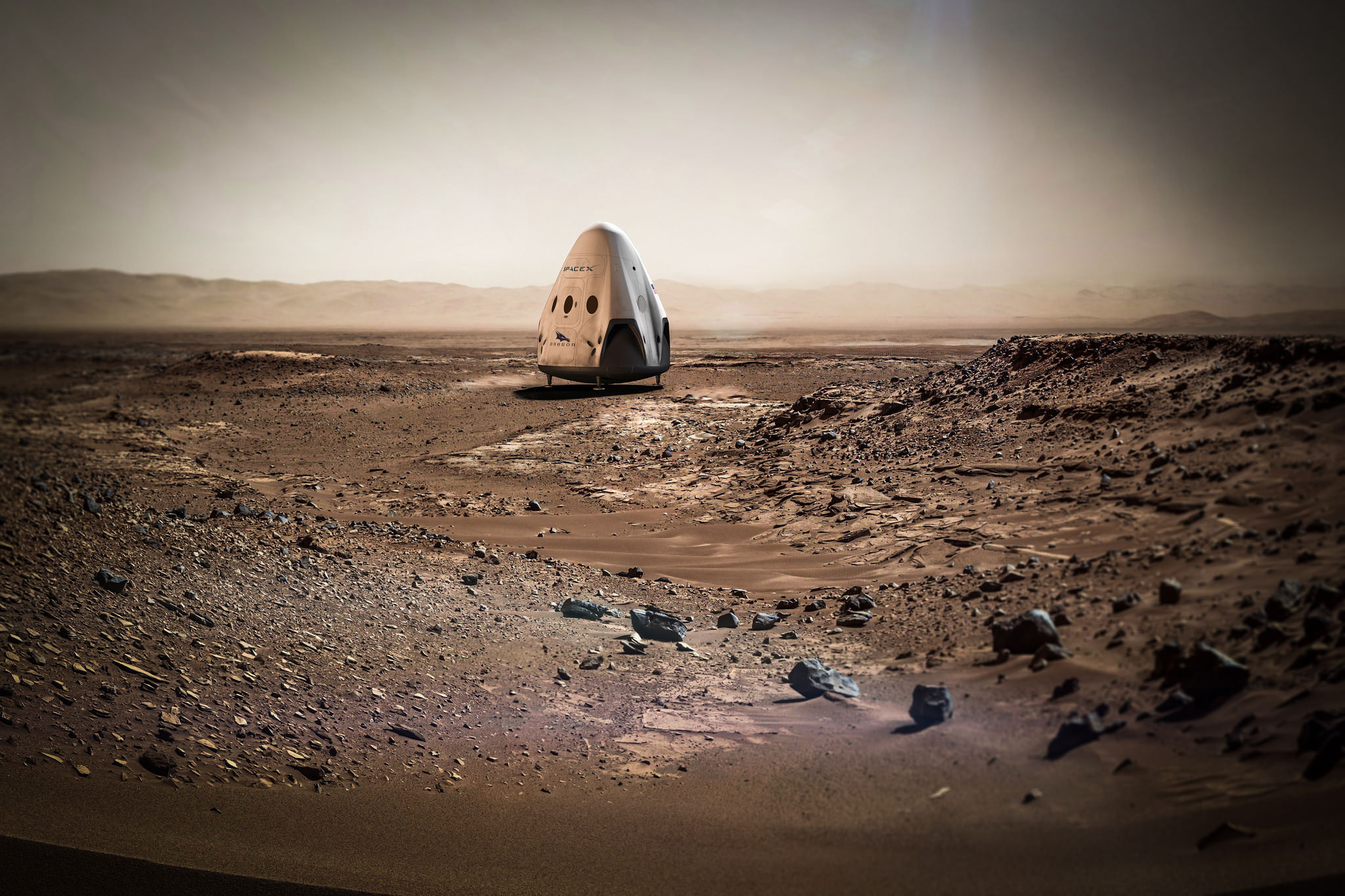
SpaceX announced plans today, April 27, for the first ever private mission to Mars which involves sending an uncrewed version of the firms Dragon spacecraft to accomplish a propulsive soft landing – and to launch it as soon as 2018 including certain technical assistance from NASA.
Under a newly signed space act agreement with NASA, the agency will provide technical support to SpaceX with respect to Mars landing technologies for the new spacecraft known as a ‘Red Dragon’ and possibly also for science activities.
“SpaceX is planning to send Dragons to Mars as early as 2018,” the company posted in a brief announcement today on Facebook and other social media about the history making endeavor.
The 2018 commercial Mars mission involves launching the ‘Red Dragon’ – also known as Dragon 2 – on the SpaceX Falcon Heavy rocket from Launch Pad 39A at NASA’s Kennedy Space Center in Florida. It’s a prelude to eventual human missions.
The Red Dragon initiative is a commercial endeavor that’s privately funded by SpaceX and does not include any funding from NASA. The agreement with NASA specifically states there is “no-exchange-of-funds.”
As of today, the identity and scope of any potential science payload is undefined and yet to be determined.
Hopefully it will include a diverse suite of exciting research instruments from NASA, or other entities, such as high powered cameras and spectrometers characterizing the Martian surface, atmosphere and environment.
SpaceX CEO and billionaire founder Elon Musk has previously stated his space exploration goals involve helping to create a Mars colony which would ultimately lead to establishing a human ‘City on Mars.’
Musk is also moving full speed ahead with his goal of radically slashing the cost of access to space by recovering a pair of SpaceX Falcon 9 first stage boosters via successful upright propulsive landings on land and at sea – earlier this month and in Dec. 2015.

The 2018 liftoff campaign marks a significant step towards fulfilling Musk’s Red Planet vision. But we’ll have to wait another 5 months for concrete details.
“Red Dragon missions to Mars will also help inform the overall Mars colonization architecture that SpaceX will reveal later this year,” SpaceX noted.
Musk plans to reveal the details of the Mars colonization architecture later this year at the International Astronautical Congress (IAC) being held in Guadalajara, Mexico from September 26 to 30, 2016.
Landing on Mars is not easy. To date only NASA has successfully soft landed probes on Mars that returned significant volumes of useful science data.
In the meantime a few details about the SpaceX Red Dragon have emerged.
The main goal is to propulsively land something 5-10 times the size of anything previously landed before.
“These missions will help demonstrate the technologies needed to land large payloads propulsively on Mars,” SpaceX further posted.
NASA’s 1 ton Curiosity rover is the heaviest spaceship to touchdown on the Red Planet to date.
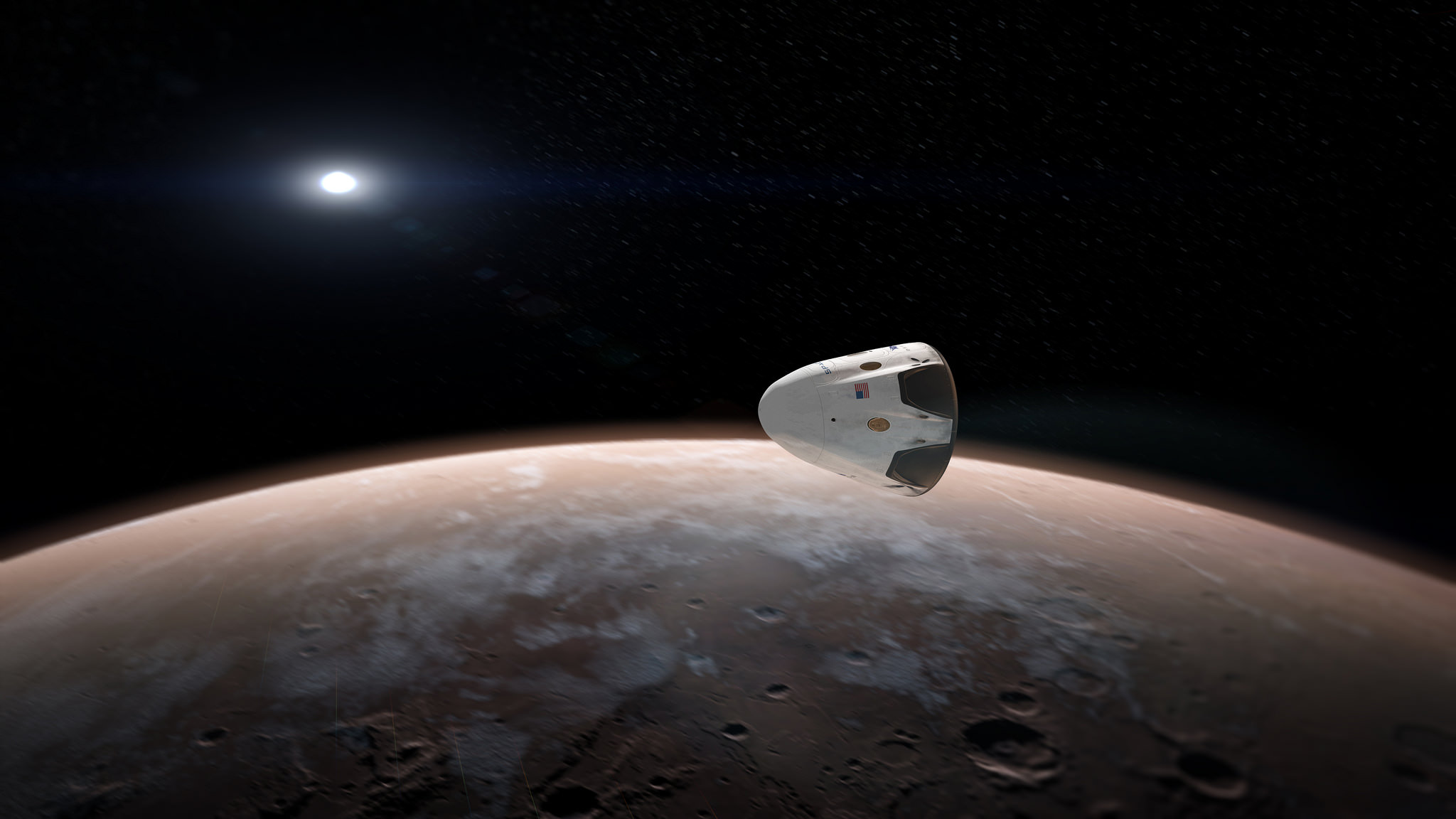
As part of NASA’s agency wide goal to send American astronauts on a human ‘Journey to Mars’ in the 2030s, NASA will work with SpaceX on some aspects of the Red Dragon initiative to further the agency’s efforts.
According to an amended space act agreement signed yesterday jointly by NASA and SpaceX officials – that originally dates back to November 2014 – this mainly involves technical support from NASA and exchanging entry, descent and landing (EDL) technology, deep space communications, telemetry and navigation support, hardware advice, and interplanetary mission and planetary protection advice and consultation.
“We’re particularly excited about an upcoming SpaceX project that would build upon a current “no-exchange-of-funds” agreement we have with the company,” NASA Deputy Administrator Dava Newman wrote in a NASA blog post today.
“In exchange for Martian entry, descent, and landing data from SpaceX, NASA will offer technical support for the firm’s plan to attempt to land an uncrewed Dragon 2 spacecraft on Mars.”
“This collaboration could provide valuable entry, descent and landing data to NASA for our journey to Mars, while providing support to American industry,” NASA noted in a statement.
The amended agreement with NASA also makes mention of sharing “Mars Science Data.”
As of today, the identity, scope and weight of any potential science payload is undefined and yet to be determined.
Perhaps it could involve a suite of science instruments from NASA, or other entities, such as cameras and spectrometers characterizing various aspects of the Martian environment.
In the case of NASA, the joint agreement states that data collected with NASA assets is to be released within a period not to exceed 6 months and published where practical in scientific journals.
The Red Dragon envisioned for blastoff to the Red Planet as soon as 2018 would launch with no crew on board on a critical path finding test flight that would eventually pave the way for sending humans to Mars – and elsewhere in the solar system.
“Red Dragon Mars mission is the first test flight,” said Musk.
“Dragon 2 is designed to be able to land anywhere in the solar system.”
However, the Dragon 2 alone is far too small for a round trip mission to Mars – lasting some three years or more.
“But wouldn’t recommend transporting astronauts beyond Earth-moon region,” tweeted Musk.
“Wouldn’t be fun for longer journeys. Internal volume ~size of SUV.”
Furthermore, for crewed missions it would also have to be supplemented with additional modules for habitation, propulsion, cargo, science, communications and more. Think ‘The Martian’ movie to get a realistic idea of the complexity and time involved.
Red Dragon’s blastoff from KSC pad 39A is slated to take place during the Mars launch window opening during April and May 2018.
The inaugural liftoff of the Falcon Heavy is currently scheduled for late 2016 after several years postponement.
If all goes well, Red Dragon could travel to Mars at roughly the same time as NASA’s next Mission to Mars – namely the InSight science lander, which will study the planets deep interior with a package of seismometer and heat flow instruments.
InSight’s launch on a United Launch Alliance Atlas V is targeting a launch window that begins May 5, 2018, with a Mars landing scheduled for Nov. 26, 2018. Liftoff was delayed from this year due to a flaw in the French-built seismometer.
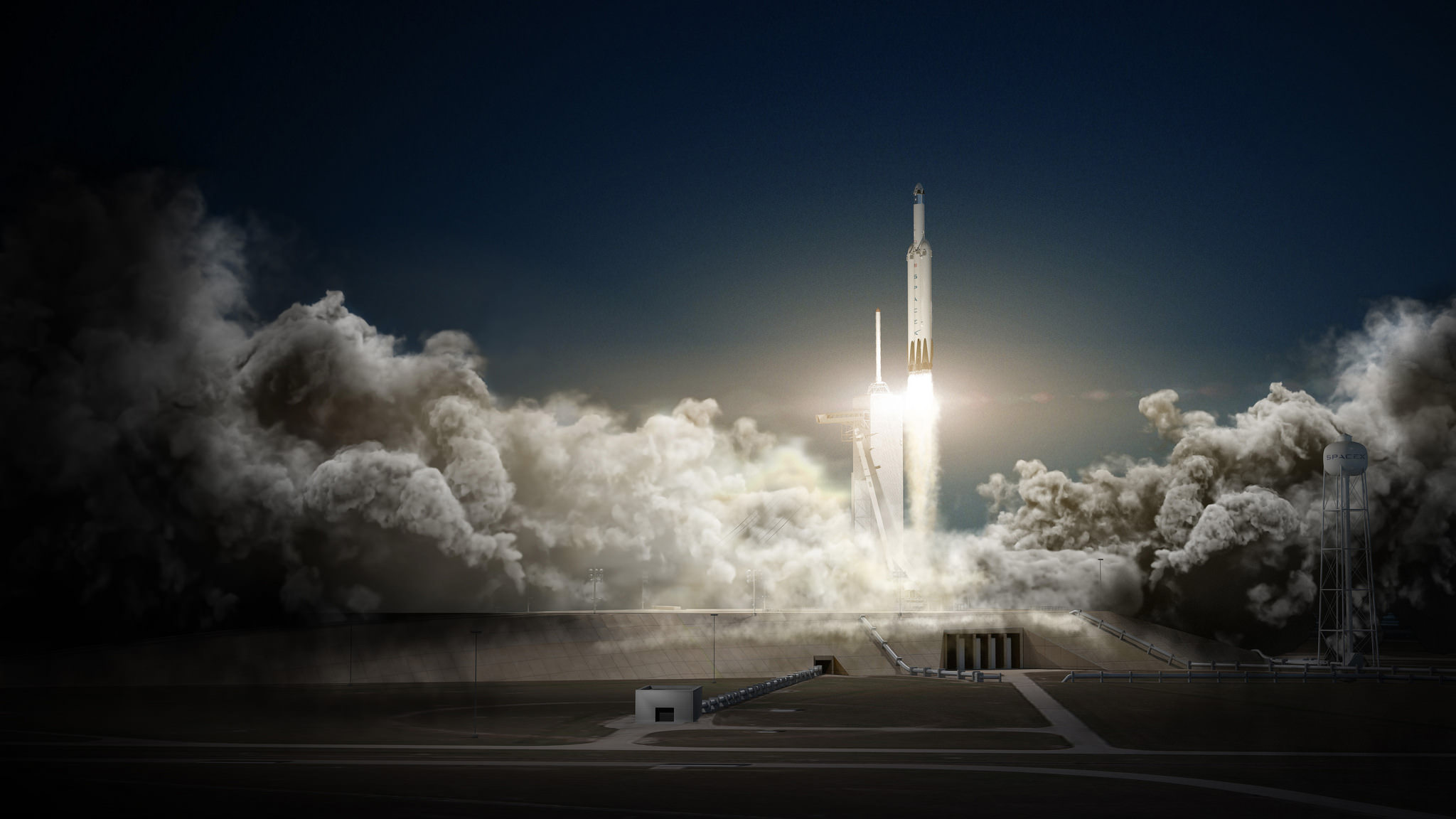
Whoever wants to land on Mars also has to factor in the relevant International treaties regarding ‘Planetary Protection’ requirements.
Wherever the possibility for life exists, the worlds space agency’s who are treaty signatories, including NASA, are bound to adhere to protocols limiting contamination by life forms from Earth.
SpaceX intends to take planetary protection seriously. Under the joint agreement, SpaceX is working with relevant NASA officials to ensure proper planetary protection procedures are followed. One of the areas of collaboration with NASA is for them to advise SpaceX in the development a Planetary Protection Plan (PPP) and assist with the implementation of a PPP including identifying existing software/tools.
Red Dragon is derived from the SpaceX crew Dragon vehicle currently being developed under contract for NASA’s Commercial Crew Program (CCP) to transport American astronauts back and forth to low Earth orbit and the International Space Station (ISS).
SpaceX and Boeing were awarded commercial crew contracts from NASA back in September 2014.
Both firms hope to launch unmanned and manned test flights of their SpaceX Crew Dragon and Boeing CST-100 Starliner spacecraft to the ISS starting sometime in 2017.
The crew Dragon is also an advanced descendent of the original unmanned cargo Dragon that has ferried tons of science experiments and essential supplies to the ISS since 2012.
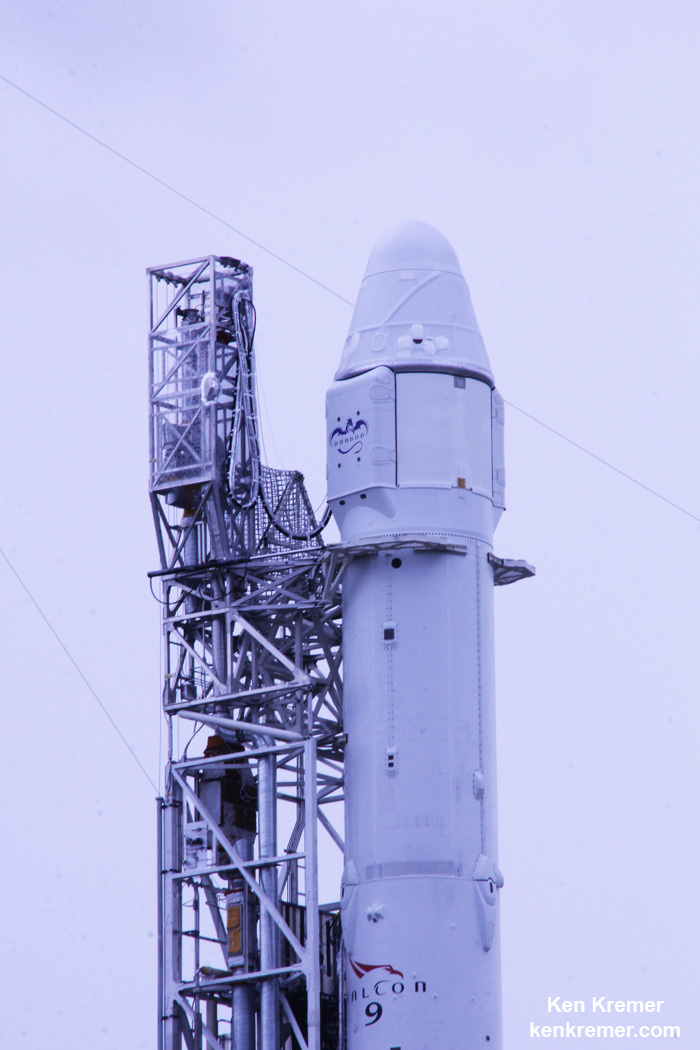
To enable propulsive landings, SpaceX recently conducted hover tests using a Dragon 2 equipped with eight side-mounted SuperDraco engines at their development testing facility in McGregor, TX.
These are “Key for Mars landing,” SpaceX wrote.
“We are closer than ever before to sending American astronauts to Mars than anyone, anywhere, at any time has ever been,” Newman states.
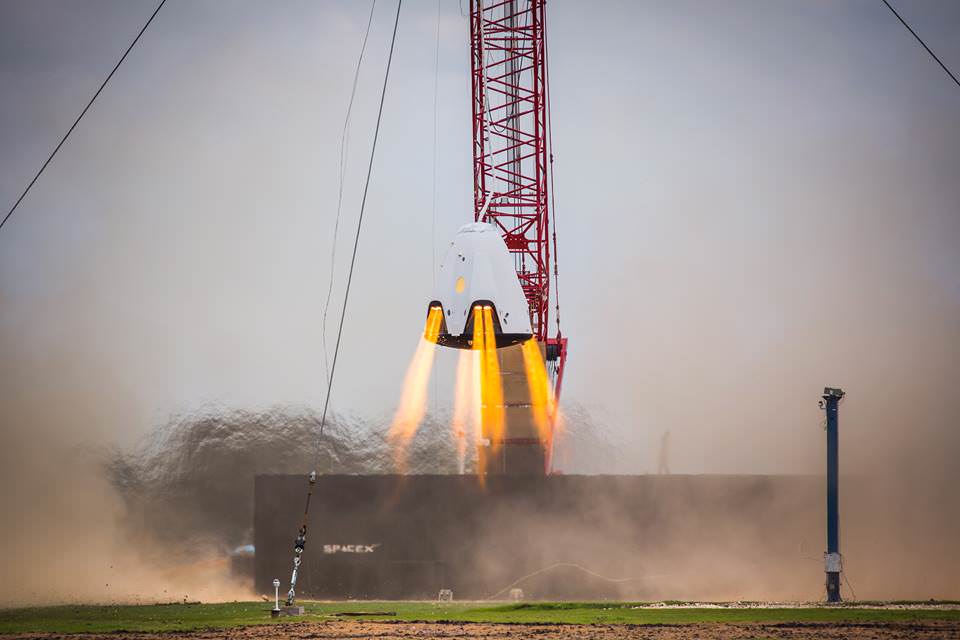
Stay tuned here for Ken’s continuing Earth and planetary science and human spaceflight news.
Book Review and Giveaway: “How We’ll Live on Mars”
Every great adventure begins with a dream. Explorers look into the unknown and set a course for discovery. Many years ago, the US launched men off planet Earth and hurtled them to the Moon. The next great space milestone is certainly to put a human boot print on Mars. In this dream and adventure of exploration, women and men will not only walk on Mars, but inhabit it.
This aspiration of putting humans on Mars is not a new one. As a spacefaring nation, we could have reached there decades ago. In How We’ll Live on Mars, author Stephen L. Petranek examines how we’ll get to Mars within this century and discusses the opportunity for a potential settlement on the Red Planet.
Find out below how you can win a copy of this new book.
As a species it seems necessary and imminent for humans to exist off this singular planet we currently reside on. How will our journey to Mars happen? What are the pitfalls? And, most importantly, who is leading the charge?
Petranek discusses how private companies are filling a vacuum left by NASA’s mothballing of the Saturn V. NASA’s primary focus on the shuttle and then its retirement has left us currently unable to launch humans from US soil. Elon Musk and his Space Exploration Technologies Corp (SpaceX) are given proper attention in this book thanks to their accomplishments thus far and their push for further achievements including a goal of Mars. Other private companies and in fact, other nations, are setting their sights on sending rovers to and eventually occupying Mars.
Chapter 6 of this book is titled “Living on Mars.” Petranek aptly notes, “Humans need four things to survive on Earth – food, water, shelter, and clothing. Humans need five things to survive on Mars – food, water, shelter, clothing, and oxygen. The successful procurement of these five essential resources will secure humanity’s future as an interplanetary species.”
This presents a major hurdle. For example, an important goal is finding accessible water – a key ingredient for human survival. Making potable water on a planet far from home is not a simple task, but it is a possible one. The challenges for survival do not end there.
How We’ll Live on Mars, a TED Books original publication, is a quick and worthy read. Stephen L. Petranek’s writing style is fluid; the information is well presented and thoughtful. The first human footprint on Mars is fast approaching reality. As a species we will tune in to watch the broadcast – albeit one with a delay for the signal travel time – of a major milestone in history. This book gives a concise examination of where we’ve been, what we’re likely to see on the road to get there and what will happen once on Mars. I recommend adding this to your reading list.
How We’ll Live on Mars is published by Simon & Schuster. Find out more about the book here.
Thanks to Simon & Schuster, Universe Today has three copies of this book to give away to our readers. The publisher has specified that for this contest, winners need to be from the US.
In order to be entered into the giveaway drawing, just put your email address into the box at the bottom of this post (where it says “Enter the Giveaway”) before Wednesday, July 15, 2015. We’ll send you a confirmation email, so you’ll need to click that to be entered into the drawing. If you’ve entered our giveaways before you should also receive an email with a link on how to enter.
Elon Musk and the SpaceX Odyssey: the Path from Falcon 9 to Mars Colonization Transporter
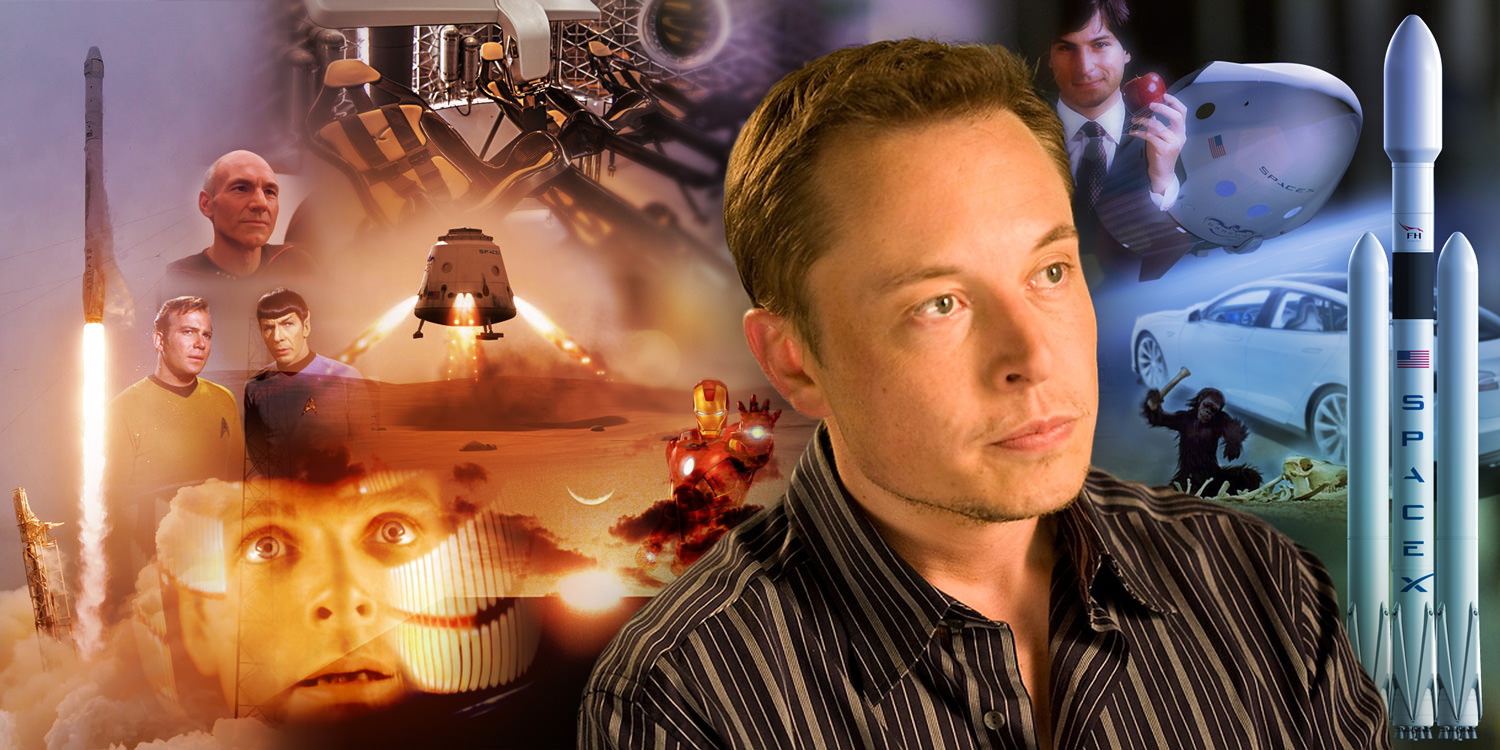
In Kubrick’s and Clark’s 2001 Space Odyssey, there was no question of “Boots or Bots”[ref]. The monolith had been left for humanity as a mileage and direction marker on Route 66 to the stars. So we went to Jupiter and Dave Bowman overcame a sentient machine, shut it down cold and went forth to discover the greatest story yet to be told.
Now Elon Musk, born three years after the great science fiction movie and one year before the last Apollo mission to the Moon has set his goals, is achieving milestones to lift humans beyond low-Earth orbit, beyond the bonds of Earth’s gravity and take us to the first stop in the final frontier – Mars – the destination of the SpaceX odyssey.
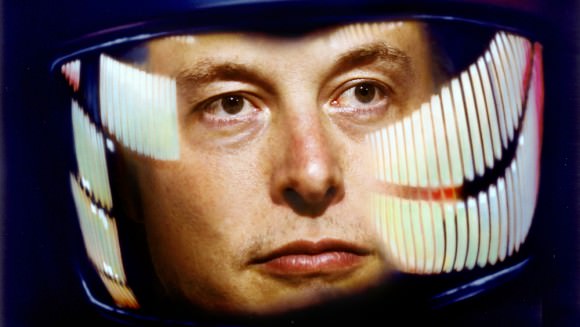
Ask him what’s next and nowhere on his bucket list does he have Disneyland or Disney World. You will find Falcon 9R, Falcon Heavy, Dragon Crew, Raptor Engine and Mars Colonization Transporter (MCT).
At the top of his working list is the continued clean launch record of the Falcon 9 and beside that must-have is the milestone of a soft landing of a Falcon 9 core. To reach this milestone, Elon Musk has an impressive array of successes and also failures – necessary, to-be-expected and effectively of equal value. His plans for tomorrow are keeping us on the edge of our seats.
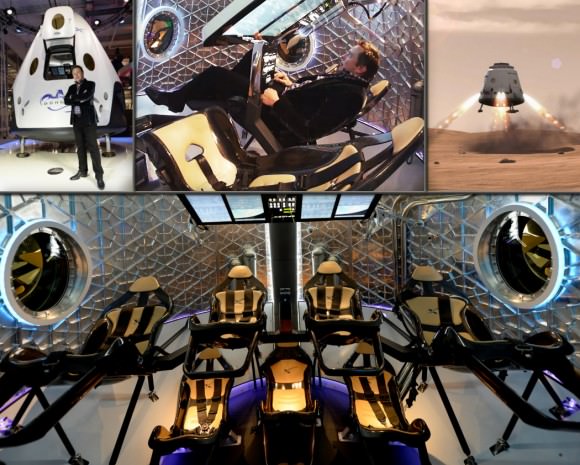
CRS-5, the Cargo Resupply mission number 5, was an unadulterated success and to make it even better, Elon’s crew took another step towards the first soft landing of a Falcon core, even though it wasn’t entirely successful. Elon explained that they ran out of hydaulic fluid. Additionally, there is a slew of telemetry that his engineers are analyzing to optimize the control software. Could it have been just a shortage of fluid? Yes, it’s possible they could extrapolate the performance that was cut short and recognize the landing Musk and crew dreamed of.

The addition of the new grid fins to improve control both assured the observed level of success and also assured failure. Anytime one adds something unproven to a test vehicle, the risk of failure is raised. This was a fantastic failure that provided a treasure trove of new telemetry and the possibilities to optimize software. More hydraulic fluid is a must but improvements to SpaceX software is what will bring a repeatable string of Falcon core soft landings.
“Failure is not an option,” are the famous words spoken by Eugene Kranz as he’s depicted in the movie Apollo 13. Failure to Elon Musk and to all of us is an essential part of living. However, from Newton to Einstein to Hawking, the equations to describe and define how the Universe functions cannot show failure otherwise they are imperfect and must be replaced. Every moment of a human life is an intertwined array of success and failure. Referring only to the final frontier, in the worse cases, teams fall out of balance and ships fall out of the sky. Just one individual can make a difference between his or a team’s success. Failure, trial and error is a part of Elon’s and SpaceX’s success.
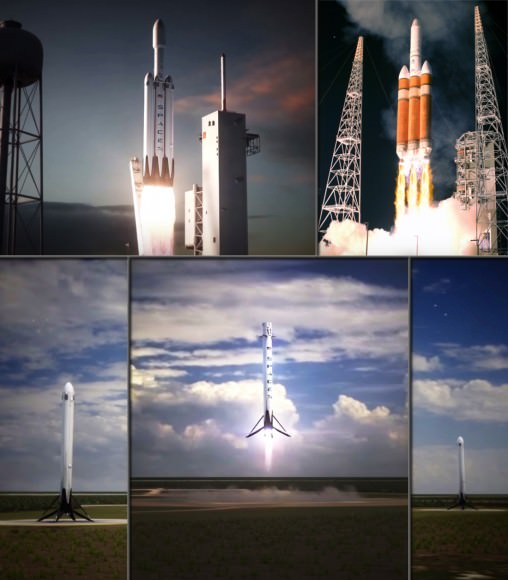
He doesn’t quote or refer to Steve Jobs but Elon Musk is his American successor. From Hyperloops, to the next generation of Tesla electric vehicles, Musk is wasting no time unloading ideas and making his dreams reality. Achieving his goals, making milestones depends also on bottom line – price and performance into profits. The Falcon rockets are under-cutting ULA EELVs (Atlas & Delta) by more than half in price per pound of payload and even more with future reuse. With Falcon Heavy he will also stake claim to the most powerful American-made rocket.

Musk’s success will depend on demand for his product. News in the last week of his investments in worldwide space-based internet service also shows his intent to promote products that will utilize his low-cost launch solutions. The next generation of space industry could falter without investors and from the likes of Musk, re-investing to build demand for launch and sustaining young companies through their start-up phases. Build it and they will come but take for granted, not recognize the fragility of the industry, is at your own peril.
So what is next in the SpaceX Odyssey? Elon’s sights remain firmly on the Falcon 9R (Reuse) and the Falcon Heavy. Nothing revolutionary on first appearance, the Falcon Heavy will look like a Delta IV Heavy on steroids. Price and performance will determine its success – there is no comparison. It is unclear what will become of the Delta IV Heavy once the Falcon Heavy is ready for service. There may be configurations of the Delta IV with an upper stage that SpaceX cannot match for a time but either way, the US government is likely to effectively provide welfare for the Delta and even Atlas vehicles until ULA (Lockheed Martin and Boeing’s developed corporation) can develop a competitive solution. The only advantage remaining for ULA is that Falcon Heavy hasn’t launched yet. Falcon Heavy, based on Falcon 9, does carry a likelihood of success based on Falcon 9’s 13 of 13 successful launches over the last 5 years. Delta IV Heavy has had 7 of 8 successful launches over a span of 11 years.

The convergence of space science and technology and science fiction in the form of Musk’s visions for SpaceX is linked to the NASA legacy beginning with NASA in 1958, accelerated by JFK in 1962 and landing upon the Moon in 1969. The legacy spans backward in time to Konstantin Tsiolkovsky, Robert Goddard, Werner Von Braun and countless engineers and forward through the Space Shuttle and Space Station era.

The legacy of Shuttle is that NASA remained Earth-bound for 30-plus years during a time that Elon Musk grew up in South Africa and Canada and finally brought his visions to the United States. With a more daring path by NASA, the story to tell today would have been Moon bases or Mars missions completed in the 1990s and commercial space development that might have outpaced or pale in comparison to today’s. Whether Musk would be present in commercial space under this alternate reality is very uncertain. But Shuttle retirement, under-funding its successor, the Ares I & V and Orion, cancelling the whole Constellation program, then creating Commercial Crew program, led to SpaceX winning a contract and accelerated development of Falcon 9 and the Dragon capsule.
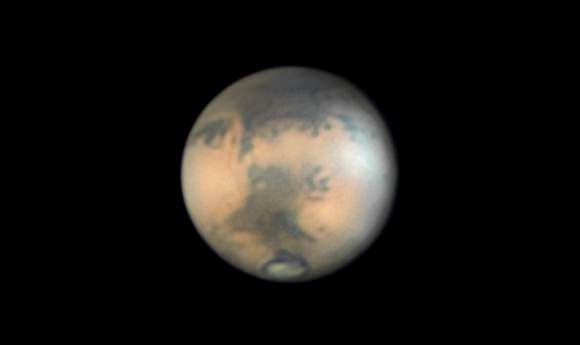
SpaceX is not meant to just make widgets and profit. Mars is the objective and whether by SpaceX or otherwise, it is the first stop in humankind’s journey into the final frontier. Mars is why Musk developed SpaceX. To that end, the first focal point for SpaceX has been the development of the Merlin engine.
Now, SpaceX’s plans for Mars are focusing on a new engine – Raptor and not a Merlin 2 – which will operate on liquified methane and liquid oxygen. The advantage of methane is its cleaner combustion leaving less exhaust deposits within the reusable engines. Furthermore, the Raptor will spearhead development of an engine that will land on Mar and be refueled with Methane produced from Martian natural resources.
The Raptor remains a few years off and the design is changing. A test stand has been developed for testing Raptor engine components at NASA’s Stennis Space Center. In a January Reddit chat session[ref] with enthusiasts, Elon replied that rather than being a Saturn F-1 class engine, that is, thrust of about 1.5 million lbf (foot-lbs force), his engineers are dialing down the size to optimize performance and reliability. Musk stated that plans call for Raptor engines to produce 500,000 lbf (2.2 million newtons) of thrust. While smaller, this represents a future engine that is 3 times as powerful as the present Merlin engine (700k newtons/157 klbf). It is 1/3rd the power of an F-1. Musk and company will continue to cluster engines to make big rockets.
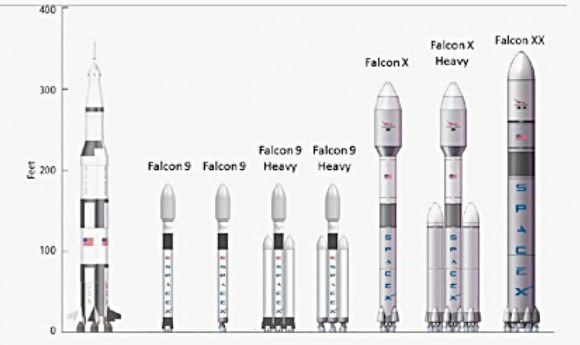
To achieve their ultimate goal – Mars colonization, SpaceX will require a big rocket. Elon Musk has repeatedly stated that a delivery of 100 colonists per trip is the present vision. The vision calls for the Mars Colonization Transporter (MCT). This spaceship has no publicly shared SpaceX concept illustrations as yet but more information is planned soon. A few enthusiasts on the web have shared their visions of MCT. What we can imagine is that MCT will become a interplanetary ferry.
The large vehicle is likely to be constructed in low-Earth orbit and remain in space, ferrying colonists between Earth orbit and Mars orbit. Raptor methane/LOX engines will drive it to Mars and back. Possibly, aerobraking will be employed at both ends to reduce costs. Raptor engines will be used to lift a score of passengers at a time and fill the living quarters of the waiting MCT vehicle. Once orbiting Mars, how does one deliver 100 colonists to the surface? With atmospheric pressure at its surface equivalent to Earth’s at 100,000 feet, Mars does not provide an Earth-like aerodynamics to land a large vehicle.
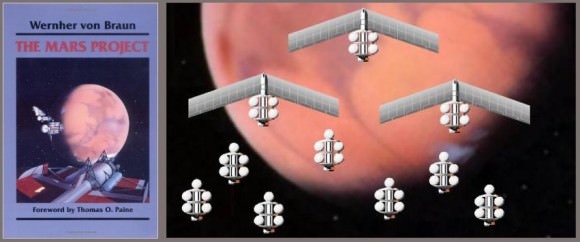
In 1952, Werner Von Braun in his book “Mars Projekt” envisioned an armada of ships, each depending on launch vehicles much larger than the Saturn V he designed a decade later. Like the invading Martians of War of the Worlds, the armada would rather converge on Mars and deploy dozens of winged landing vehicles that would use selected flat Martian plain to skid with passengers to a safe landing. For now, Elon and SpaceX illustrate the landing of Dragon capsules on Mars but it will clearly require a much larger lander. Perhaps, it will use future Raptors to land softly or possibly employ winged landers such as Von Braun’s after robotic Earth-movers on Mars have constructed ten or twenty mile long runways.
We wait and see what is next for Elon Musk’s SpaceX vision, his SpaceX Odyssey. For Elon Musk and his crew, there are no “wives” – Penelope and families awaiting their arrival on Mars. Their mission is more than a five year journey such as Star Trek. The trip to Mars will take the common 7 months of a Hohmann transfer orbit but the mission is really measured in decades. In the short-term, Falcon 9 is poised to launch again in early February and will again attempt a soft landing on a barge at sea. And later, hopefully, in 2015, the Falcon Heavy will make its maiden flight from Cape Canaveral’s rebuilt launch pad 39A where the Saturn V lifted Apollo 11 to the Moon and the first, last and many Space Shuttles were launched.
References:
National Aeronatics and Space Administration
Happy Birthday to my sister Sylvia who brought home posters, literature and interest from North American-Rockwell in Downey during the Apollo era and sparked my interest.



